RECREATION IN CHINA
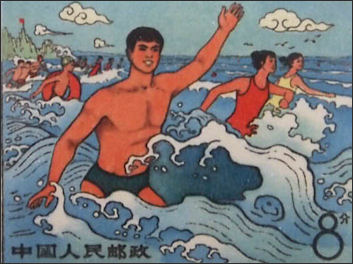
The Chinese are not very outdoors oriented. In a survey by polling company Environics 14 percent of the Chinese that were asked said they very often spend their leisure time in a natural place such as a park or countryside (compared to 47 percent in the United States) and 39 percent said they sometimes spend time in natural places.
Among those who do like the outdoors walking or doing some activity in a park are popular pass times. Many people exercise in the morning before work, sometimes as early as 5:30am. In the 1960s, loudspeakers on the streets used tell everyone in school, shops and offices that it was exercise time. "Train for 10 minutes every day," Chinese citizens were told, "and you'll be able to serve the cause of socialism for 10 additional years."
Some Chinese yuppies in Shanghai practice of urban mountaineering, using ropes and carabineers to climb skyscrapers and pitching tents and sleeping on the roofs. In Beijing, there are restaurants where customers are encouraged to break plates as long as they pay for them.
China International Shooting Range (Changping district's Nankou town) allows patrons to to shoot all kinds of military-grade weaponry, including AK-47 and M-16 automatic machine guns, mortars and even anti-aircraft cannons. The operators charge by the bullet, with larger ballistics costing more. The former military barracks feature displays of about 100 weapons from around the world and a paintball course. [Source: China Daily March 19, 2009]
See Separate Article RECREATION, ENTERTAINMENT AND GAMBLING factsanddetails.com
Park Games in China
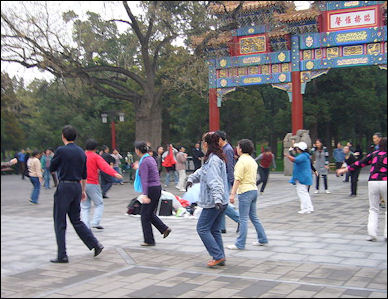
”San mao” (“three feathers”) is a game played with wooden paddles and three feathered shuttlecocks. The shuttlecocks are often homemade from a white rubber tip, like that at the end of spring-type door stops, a piece of bicycle tire to which three feathers — often from a home-slaughtered chicken — are attached to give the contraption aerodynamics.
One man who has been walking backwards for an hour every evening in the Temple of Heaven Park in Beijing for 20 years told the New York Times, “It’s hard to say why I like walking backward. I can exercise muscles you don’t use when you walk forward. And it makes me comfortable.” He also said that it forces his tummy in and keeps his back straight.Shuttlecock is a game in which a weighted, feather-topped shuttlecock is kicked over the net with any part of the body except the hands and arms. “Jian zi” is a game similar to hacky sack played with shuttlecock sold by vendors for around 65 cents a piece.
Croquet (known as the "gate game") is popular among elderly Chinese. Some play very aggressively and get particular pleasure from whacking their opponent's ball. They play with three wickets and a single post.”Ti jian xi” is a hackey-sack-like game in which people kick a large shuttle cock around in a circle.
Out of Shape China
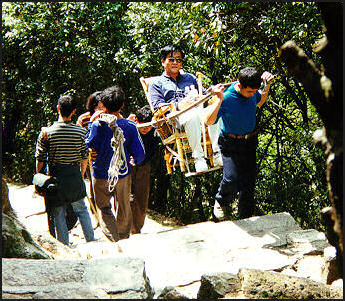
Carried in a sedan chair up a mountain “When it comes down to ordinary citizens rather than Olympic athletes, China is hardly the sports capital of the world,” Kent Ewing wrote in the Asia Times. “Indeed, it remains a backwater. China won a stunning 51 gold medals at Beijing in 2008 and built first-rate facilities to train athletes and paid coaches handsome salaries to manage that training, yet sports venues for ordinary Chinese remain few and far between in a nation that is woefully out of shape.[Source: Kent Ewing, Asia Times, September 5, 2008]
China seems to be getting fatter in the cities while remaining undernourished in the countryside. Most Chinese continue to live in rural areas, where poverty and malnourishment are commonplace. At the same time, in the burgeoning cities, American-style obesity has become a problem. According to the most recent data from the Ministry of Education, 8 percent of urban Chinese children between the ages of 10 and 12 are obese, while another 15 percent are overweight. Compare that to a 2006 report by the US Department of Health and Human Services, which did not identify a separate category for obesity but found that 18.8 percent of Americans aged 6 to 11 were overweight.
A national fitness program, introduced by the State Council, the cabinet, in 1995, has largely been deemed a failure. A new national fitness program, introduced after the 2008 Olympics which has set a goal of motivating 40 percent of the population to take up regular exercise by 2010, is supposed to improve matters. Part of this is requiring children to take one period of physical education every day in school. “But the truth is that daily exercise in many schools amounts to little more than 10 minutes of stretching, and real exercise and participation in sports remain outside the experience of most Chinese.” Ewing wrote. “At the same time that the country has become an international sports superpower, it has not done much to encourage a sports culture at home.”
Exercise in China
Chinese exercise balls, which are rotated around in the palm of the hands, have been around for at least 800 years. They are "beautifully handcrafted, 45mm, hollow polished chrome" and "fit perfectly into the average man's or woman's hand." A pair was given to U.S. president Ronald Reagan when he visited China.
In and around small parks in Chinese cities there are exercise stations with bars, swiveling ground-level lazy suzans, pendulums and hoops and other things, where older people like to gather and hang out and occasionally do a couple of exercises. Chinese joggers that you see in parks are sometimes dressed in black slacks, white dress shirts and cloth shoes or plastic sandals.
Lack of Sports Facilities in China
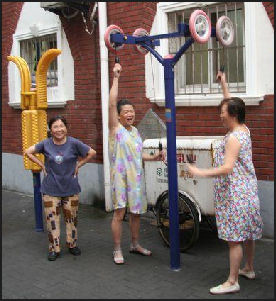
Street exercise machines State media has reported that Beijing pumped 480 million yuan (US$70 million) into elite sports in 2005, while only 270 million yuan went toward public sports venues. A General Administration of Sport survey found there were 6.58 sports venues per 10,000 people in China, not even close to what can be found in most developed countries. For example, Japan has 200 sports venues per 10,000 people. Especially in rural areas, where only 8 percent of China's total sports facilities can be found, it's hard to find a place to play badminton, table tennis or any other sport. [Source: Kent Ewing, Asia Times, September 5, 2008]
Typically, in China's many villages, the only public space for exercise is the playground of the local school. In Beijing and other big cities in the prosperous east, it is mostly the elderly one sees taking over public parks and even sidewalks for their daily dose of tai chi while the younger generation is too busy making money to take regular exercise. And, even in these cities, sports venues can be hard to find and expensive to use.
The technical operations manager of the Fengtai Olympic softball field, Sun Bojie, recently complained that there were only six softball fields in Beijing, a city of more than 17 million residents. No wonder, he said, the game had failed to capture the public imagination.
Bowling in China
Bowling is very big in China these days. Beijing and Shanghai have 24-hour bowling alleys like the Golden Altar complex, which boasts 50 lanes, a health club, VIP lanes, a hotel and private rooms. A Taiwanese businessman built a 100-lane facility on the grounds of the Workers Stadium in Beijing.
The bowling craze began in earnest in the 1990s in southern China, after being introduced from Hong Kong and Taiwan, and then spread north. Between 1993 and 1995, 30 bowling alleys with 1,000 lanes was built in Shanghai. The Golden Altar sometimes has a waiting list of 200 people waiting for lanes.
Many young couples go bowling for a date. For a while it replaced karaoke as the latest fad. Well-healed customers play any time they feel like it. Many ordinary Chinese without a lot of cash take advantage of special rates offered for people who play after midnight. Sometimes they play with special "cosmic balls" that glow in the dark.
Bowling was so popular for a while that bowling alley investors could recoup their investment in 18 months. By the mid 1990s two or three bowling allies were opening up in China every week and, according to some sources, bowling equipment was the third largest exports from the United States to China after jet planes and soybeans. American companies like AMF and Brunswick got rich supplying 80 percent of the bowling equipment used in China. In 1996, AMF earned 40 percent of it revenues from China. .
Bowling is expected to become a $10-billion-a-year business. In Japan, South Korea and Taiwan the bowling craze peaked, crashed and then stabilized. The same will probably happen in China.
Billiards, Snooker and Pool in China
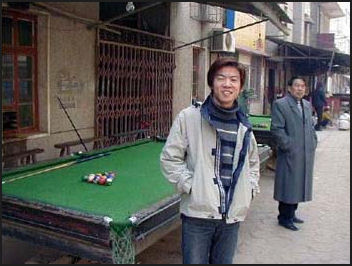
Pocket billiards is also very popular and it seems to have replaced ping pong in many areas as the major pass time. Women often play as well as men.
Sidewalk billiards is popular in many places. In rural areas half-size pool tables are a common sight along the roads. Many towns have small time entrepreneurs that make money rolling wheel-mounted outdoor pool tables around from neighborhood to neighborhood and charging customers around 20 cents per game.
Snooker is also very popular. More than 60 Chinese million play the game regularly, and 66 million tune in to watch major televised tournaments such as the British Open. By contract around 40 to 50 million watch Formula One races and European soccer games. There are 5,000 places in China where people can play snooker, including 800 snooker clubs in Beijing and 250 super clubs that have more than 50 tables.
As of the mid 2000s, China was home to five professional snooker players, including three who play on the main tour. British snooker players like Steve Davis and Jimmy White are popular in China. Huge crowds come to watch snooker tournaments. At a world snooker tournament held in China in April 2005 fans had to be repeatedly told to pipe down, turn off their cell phones and display proper manners.
Some Chinese snooker players have attained rock-star-like status. Jin Long was the 2002 under-21 world champion. In December 2005, Ding Junhai, a Chinese teenager, became the first play from outside the British Isles to the win the prestigious British Snooker Tournament. He beat six-time world champion Steve Davis in the final. Ding was 18. Davis was 48.
China hosted the a world snooker tournament in 2006. For weeks after there were snooker matches on television
In April 2011, top-ranked pool player, 22-year-old Wu Chia-ching, became the first Taiwanese sportsman to give up his citizenship in order to compete for China. Wu was a world champion in 2005.
Snooker Player's Anti-China Tweets
In February 2012, The Mirror reported: “Snooker bad boy Mark Allen is facing a massive fine after an amazing attack on the locals at the Haikou China Open. Top brass in this country have hit the roof after a string of insulting tweets from the Northern Ireland cueman ahead of the event in Beijing. Soon after arriving, world No.12 Allen tweeted: "This place is horrendous!" "Dead cat found this morning. Any wonder this place stinks. Must be dead cats all round the town." [Source: The Mirror, February 29, 2012]
Allen, 25, added: "Journey a nightmare. People are ignorant. Place stinks. Arena's rubbish, tables poor, food is horrendous. Other than that I love China." He went on: "Just to let everyone know, I'm not spoilt, disrespectful or ungrateful. Simply telling it how it is." He later backtracked — sort of — tweeting: "Might've been a bit harsh a few hours ago in my tweet. Not all Chinese people are ignorant. I stand by everything else though."
Challenged on his views by fans, Allen went on: "So it's ok to stand and spit next to someone while waiting on an elevator Or p*** lying in the street Didn't think so." Incredibly, Allen's comments have come after the second of two letters was sent out to all players only last week reminding them that they are ambassadors for the sport and warning them about their comments on Twitter.
Snooker chiefs are particularly angry as the letters reminded players that they are role models who are looked up to by youngsters....Allen's gaffe is particularly sensitive as it comes at a time when the sport is as popular in China as it was in Britain at its peak in the 80s. World Snooker chiefs fear Allen's comments could go down particularly badly with sponsors in the Far East.
WPBSA chairman Jason Ferguson said last night: "Mark Allen"s comments are extremely disappointing considering that China is a great friend of our sport." "There has been a massive effort from China to support our players and I am sure this is an isolated view from one player.Our players must understand that their views expressed in the public arena can have a catastrophic effect on the games development. These comments will now be reviewed by the WPBSA disciplinary committee."
This week's controversy is the latest in a growing list associated with Allen. A month before he was fined and warned as to his future conduct after swearing during a press conference at the UK Championships in York. Allen had also called on World Snooker chairman Barry Hearn to resign as part of a series of damning criticisms of the entrepreneur’s reign so far. Hearn responded by threatening legal action and branding Allen "a silly little boy". Allen turned up for his subsequent post-match press conference with his mouth covered up by a piece of black tape and initially sat in silence for around 15 seconds before eventually agreeing to speak. He and Hearn have since resolved their differences but Allen also clashed with fellow professional Stuart Bingham last year, accusing him of having "no bottle and no balls" at the Australian Goldfields Open in July.
Health Clubs in China
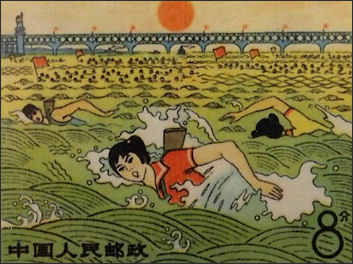
Swimming the Yangtze stamp
from 1976 Health clubs gave become very popular with yuppies, noveau rich and urban middle class. Members often pay $1,000 a year, a considerable sum in China. One stressed out restaurant manager who credited working out with lowering her weight and helping here insomnia problems told AFP, “I feel it is worth it for people to pay one fifth or one tenth of their incomes on getting fit. It gives people good health, it gives people happiness, and we can make more friends.”
The heath club business has expanded very quickly. In the late 1990s health clubs were largely nonexistent outside luxury hotels. Now there are 200 to 300 in Beijing alone. Among the popular chains are California Fitness, endorsed by Yao Ming and Jackie Chan.
As of 2004, there around 2,000 health clubs of various sizes in China, including some fancy ones with advanced machines in Shanghai. When the fancy clubs first opened up, demand was high among Chinese yuppies and they were able to get away with charging members about $1,200 a year. Competition later drove the price down to about $360 a year, still a considerable sum for the average Chinese.
Health clubs are viewed more as places to socialize, hang out and be seen than places to exercise. One regular customer at the Total Fitness Club in Shanghai told the Los Angeles Times, the main reason he goes to his club is to play Internet war games for free at the bar. The owner of the three-story Megafit club told the Los Angeles Times, “Joining a gym is still a very new concept in China. Most of our members see it as a kind of fashion statement, not necessarily linked to their health.”
Pole Dancing in China
Strip-show-style pole dancing is promoted as a form of exercise in China, with a number of health clubs and dance schools offering pole dance classes. The Lolan Pole Dancing School in Beijing had five studios in mid 2008 and planned to open six more before the end of the year.
One satisfied customer at Lolan told the New York Times, “I used to take a normal aerobics class but it was boring and monotonous, so I tried out pole dancing. It’s a really social activity. I’ve met a lot of girls here who I’m now close friends with. And I like that it made me feel sexy.” Another said, “I’ve been studying Chinese dance for many years but this is totally different. I feel in control when I do this. If I learn this well, I feel I can be a superstar. I want to be a superstar.”
Luo Lan, the founder of Lolan Pole Dancing School, said she got idea for the school after witnessing pole dancing for the first time in Paris in 2006. She thought if she took away some the shadier aspects associated with the dance and packaged it right she could create a new exercise craze. She told the New York Times, “People here have never seen a pole dance, and for that reason they don’t associate it with the stripping of women of ill repute. I knew if I could give people a positive first impression of this as a clean fun, social activity, people wouldn’t just accept it, they’d embrace it.”
Not long after she started her first school, Luo was written up in magazines and appeared on television. Rival schools opened up. In Guangzhou the Total Fitness Club offers pole dancing, salsa classes and six kinds of yoga at its 11 branches.
Male Pole Dancers
Tiffany Tan wrote in the China Daily, Pole dancing “attracts both male and female dancers - and nobody blinks an eyelash. Some male dancers writhe and gyrate more seductively than women, while others move with the power and precision reminiscent of gymnasts. Among the latter is 23-year-old Li Hongliang. As a fourth year arts management major at Beijing Contemporary Music School, he's trying to make ends meet by working part time as a gym trainer. He also moonlights as a pole dancing instructor. [Source: China Daily,Tiffany Tan, May 15, 2011]
Li discovered pole dancing at a Beijing gym three years ago and soon after signed up for lessons. A year and a half later, he began teaching. "I like the techniques used in pole dancing and how it can show off a guy's masculinity," says Li, who, in his cargo pants, sleeveless shirts and sneakers, makes striking a pose 5 feet off the ground look effortless.
"I hire male instructors to help correct stereotypes about pole dancing," says Luo Lan, 41, who put up Lolan Pole Dancing after seeing the dance performed during a Paris trip 10 years ago. "I want people to know it not only as an erotic art but also as a healthy physical activity for both men and women."
Roller Disco in China
In recent years roller disco has become popular in Shanghai and other Chinese cities. Surprisingly some of its biggest enthusiasts are migrant workers. The owner of Xinxiang, a basketball-ball-court-size roller rink that welcomes hundred of workers almost every night, told the China Daily in 2010, “When we started five years ago, the people who came here to skate were mostly local youngsters...As the country started its economic reforms, a lot of workers from other provinces came to this city, and now some of these migrants are also coming here for recreation and exercise.”
The entrance fee to Xinxiang is about $3. Skate rental is an additional 80 cents. A 22-year-old salesman from Chongqing told the China Daily, “I come here often because I work near this place. My friends kept asking me to come, and there’s a good crowd here, and prices here are relatively cheap for a city like Shanghai.”
Middle Class Recreation in China

Chinese hikers Western middle class sports like biking and jogging are catching on in China. In the mountains outside Beijing people are cross country skiing. In the grasslands of Inner Mongolia they are mountain biking. Many of the competitors in the 100-kilometer ultramarathon from the Great Wall of China to the Ming Tombs are locals. There is even a guy that dives off a cliff at 25-meter-high Diaoshuilous waterfall in Heolongjiang Province. [Source: AP, China Daily]
Chris Renner of the sports marketing agency Helios Partners told AP, “If you do consumer-based research, you’ll find that amazingly, unlike the United States, when you see people participating, doing walking, running, badminton, swimming [in China], they’re all higher-level income...They’re higher level income because they’re the only ones who have leisure time. The 800 million people working in the fields don’t have time for that and certainly the migrant workers don’t have them for that.
Peter Hessler came across a health names ate the Al Pacino movie “Scent of Women”.
Skateboarding in China
Skateboarding has not really caught on in China even though American skateboard companies like Quicksilver are trying hard to promote the sport. As of the mid 2000s, skateboarding websites scored lots of hits and extreme sports were ranked high in surveys among middle school students of “the top five coolest things to do “but still you don’t see many skateboarder on the streets.
For many young urban Chinese skateboarding is just a fashion. Skateboarding events are often well attending but the spectator never think of doing the stunts or even riding a skateboard themselves. Quicksilver initially had great ambitions to make big money in China but like foreign companies in all business sectors, the company has found the going can be quite slow trying to introduce a new idea to China.
In many ways American skateboarding companies are trying to sell the American skateboarder lifestyle. If they end up selling it as a fashion rather than a sport so be it as as along as merchandise moves off the shelves. One of the biggest obstacle to popularizing skateboarding in China is the lack of free time among young people. There is also an inherent shyness among young Chinese to do anything really radical or out of step with the demands of the their culture. The skateboarders you do see are often in the parking lots of empty stadiums.
Surfing has not really caught on either, in part because they are not really any good waves in China except when there is a typhoon out at sea. Snowboarding is not very big either but perhaps has the best chance of catching on.
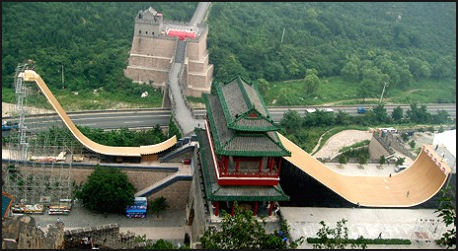
Danny Way skateboards over the Great Wall of China
Skateboarding Over the Great Wall of China
Danny Way, “the Evel Knievel of skateboarding,” drew international attention when he leaped over a 22-meter-wide section of the Great Wall of China outside Beijing, using a 20-meter ramp that propelled him to speeds of 90 kilometers an hour and landed on a 30-meter ramp and then went flying up a nine-meter-tall quarter pipe. In doing the jump he broke the world’s records for longest jump, highest air on a vertical ramp and the highest speed on a skateboard.
Way revolutionized skateboard ramp jumping by building the biggest and the baddest ramps. The father of “Big Air “competition at the X Games, he once suffered serious swelling and bruising around his brain stem and spinal chord from a surfing accident that temporarily left him unable to move and kept him from doing sports for more than a year. On the Great Wall jump he said, “I’ve always wanted to know what I’m capable of jumping on my skateboard. Its more than the jump itself. I’ve always wanted to put something special between the jump, something that symbolized something beyond skateboarding to the rest of the world.”
Ways jumps, bankrolled in part by the Quicksilver skateboard company, have been part of Quicksilver’s campaign to bring skateboarding to China in a big way. On the coat tails of the jump Quicksilver opened 20 shops and a 200,000 square feet concrete skate park, one of the largest of its kind in the world, in Shanghai. The Chinese government gave Way formal approval for the jump and unveiled a Chinese Extreme Sports Association to sponsor events, train referees and judges and recruit and train talent. It is not quite clear how much the rebellious skateboard attitude will be tolerated in China.
Surfing in China
China does not have great surfing because its coastline is blocked by Japan and the China coastline is at an angle so it doesn’t receive the full force of the Pacific Ocean. The beaches often tend to be muddy rather than sandy and the water brown rather than blue. The best surfing is when a typhoon is out at sea.
There are some decent surfing spots in the warm, relatively clear seas on Hainan Island. Until recently most of the surfers have been Japanese and Westerners. But these days an increasing number of Chinese are showing and interest in the sport.
A Chinese scuba diver who decided to take up surfing told the China Daily, “When you go out and surf, when you catch a wave the feeling is always different. Also when you stand up, you feel like you’ve achieved something. A natural high. The world ceases to exits. It’s just you and the wave.”
In 2009, Santa Crux Surfboard organized a surfing event, with Robert “Wingnut “Weaver, star of the surf movie “Endless Summer II”, that featured a beach barbecue, drinking and surfing. More than 90 percent of the participants were Chinese.
Skiing and Winter Sports in China
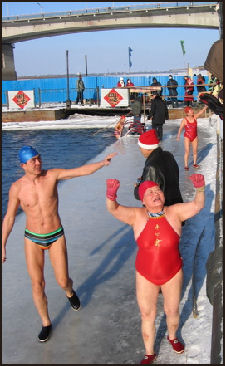
Wiinter swimming in Harbin
In the mid 1990s there were no ski resorts and only 500 skiers in all of China and most of them were professional athletes. By 2005, about 5 million Chinese were hitting the slopes at 200 ski resorts. Most of the resorts have less than 10 runs and a vertical drop of less than 500 meters. Most of the ski resorts are in the mountains north of Beijing. The largest resort, Yabuli, is near the Russian border. It hosted the ski events of the 1996 Asian Winter Games.
Skiers at the Nanshan ski resort east of Beijing tend to flock to beginner slopes and avoid the more difficult runs. Much of the snow is artificially made. Between runs skiers drink green tea rather than hot chocolate and snack on broiled pork and egg-filed crepes with scallions and hot sauce.
A cliff painting discovered in Xinjiang in the early 2000s suggested that Stone Age men in the region skied. There is an indoor ski slope in Shanghai or least there was.
Some Beijingers take regular wintertime dips in holes broken through the ice in Sichahai Lake north of Beihai Park. The swimmers contend that taking a daily dip in the icy water is good for one's health. In Harbin, swimmers do the same cut holes in the ice in the river. The custom was introduced by Russians. See Places.
Chinese also like to get around on the ice on frozen rivers and lakes in ice chairs and sleds propelled forward with hand-held spikes.
Hiking and Fishing in China
The Chinese like hiking but many take their time going up mountains. They like to walk up a few flights of stairs that are found on China's most well-known mountains and rest, take some pictures and enjoy the view and then hike up a few more flights and repeat the same process. Some do this wearing suits or dresses.
Chinese hikers like to carry walking sticks and often hike in huge groups that begin their hike at 3:00am so they can catch the sunrise from the summit of a mountain. Some people choose to be taken up mountains in rattan sedan chairs carried by two men holding two 15-foot-long bamboo poles. These chairs are used on trails above dangerous cliffs.
China has “pay as you catch “fishing ponds and lakes. One in Ritan Park in Beijing park is about half the size of a football field and partly covered by pink lotus flowers. It is stocked with fish various kinds of carp. Fishermen pay about $1.00 a kilogram for the fish they catch. Some fishermen show up at dawn and take what they catch home for lunch. Many fishermen smoke while they fish and have special platforms to sit on that jut out into the pond. Using a hook baited with an artificial gum that emits an odor said to attract fish one fisherman told the Washington Post he was able to catch about seven or eight fish an hour. In many places the stocked ponds are the size of swimming pools.
Horseback Riding
Horse breeding and riding are becoming increasingly popular among China’s nouveau riche. The owner of Beijing door factory, who own three thoroughbreds, told AFP, “Horses are a hobby for me, not investment objects. Riding is a form of communication without language, where man and horse try to understand each other.
In 2008, there were more than 100 riding clubs in the Beijing area, up from 80 a year before. The Equuleus International Riding Club was founded near an upscale villa compounds outside of Beijing in the 1990s mainly to meet the needs of the expatriate community but now is used mostly by wealthy Chinese. Many of its 100 or so horses are retirees from the jockey clubs in Hong Kong and Macao.
Polo in China
Julie Makinen wrote in the Los Angeles Times: “ Though China's association with the sport can be traced back more than a millennium, it fell out of favor for centuries, and there were no polo venues on the mainland a decade ago. As the country's capitalist economy has soared and the nation has cast off Mao-era proscriptions against bourgeois pursuits, about half a dozen polo clubs have opened in Beijing, Shanghai and Tianjin. [Source: Julie Makinen, Los Angeles Times, January 28, 2014 ==]
According to AFP: “China has a long equine history, with the first cavalry troops recorded in the Spring and Autumn Period of 770 B.C.- 476 B.C. and ceramic horses unearthed alongside the later Terracotta Warriors. Chen also claims polo had its origins in the Tang dynasty China before a British army officer imported it from India, although he acknowledges that "We all agree modern polo started from England."[Source: Agence France Presse, July 31, 2014]
“Nonetheless indigenous Chinese horse breeds are too small for many modern equestrian disciplines, he admits. The country's main equine stock is descended from Mongolian strains, but for centuries the animals of the steppe were bred primarily for stamina, rather than explosive speed. Most polo ponies are imported — with three-quarters of the animals at the Tango club coming from Argentina. China imported fewer than 300 horses in 2005 but the number has risen tenfold in less than a decade. Now the country has about 500 riding clubs and half a million amateur enthusiasts, according to Wutzala, an ethnic Mongolian who uses only one name and runs the www.horse.org.cn website. ==
Snow polo is also played in China. Tianjin hosted the Snow Polo World Cup 2014. The tournament, sanctioned by the Federation of International Polo, is one of only a few snow polo competitions in the world. (St. Moritz and Aspen also host events.). Harvey Lee, the manager of a polo club, told the Los Angeles Times snow polo is ideal for newcomers, since the field is half the normal size, the action is slower, and the bright orange ball is twice as large as the one used when playing on grass, making the game easier to follow. A massive video screen also helps. [Source: Julie Makinen, Los Angeles Times, January 28, 2014 /=/]
John Fisher, a Briton who serves as year-round director of stable operations at the Tianjin club, told the Los Angeles Times that although there are challenges in bringing polo to China — such as animal welfare protocols and language barriers — the sport has a bright future in the nation. "What they're doing here is amazing," said Fisher, who played on the Hong Kong China team at the recent tournament. "Everything here is bigger and better." /=/
See Rich Under Society
Image Sources: Louis Perrochon ; Roadtrip.com; Poco Pico; 21st century Paladin com; Julie Chao ; Alan Arnette; Wiki Commons; stamps ; Asia Obscura
Text Sources: New York Times, Washington Post, Los Angeles Times, Times of London, National Geographic, The New Yorker, Time, Newsweek, Reuters, AP, Lonely Planet Guides, Compton’s Encyclopedia and various books and other publications.
Last updated July 2015
